Archaeologia Volume 17 Section XXIX
Archaeologia Volume 17 Section XXIX is in Archaeologia Volume 17.
An Account of some Druidical Remains in the Island of Guernsey. By Joshua Gosselin, Esq. in a Letter addressed to the Right Hon. Sir Joseph Banks, Bart. K.B., P.R.S., F.S.A. Read 5th December, 1811.
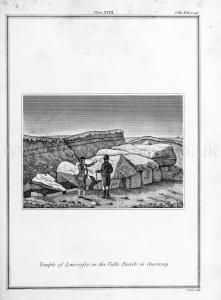
Guernsey, November 9th, 1811.
My Dear Sir,
A small temporary redoubt was constructed some few years back, on a height near the shore, on the left of Lancresse Bay, three miles from the town in this island. The ground on which this redoubt stood, being composed of a sandy turf, was by degrees levelled by the wind, and the edges of some stones were thereby discovered, which, upon inspection, I immediately knew to belong to a Cromlech or Druidical Temple [Les Vardes Burial Mound [Map]]. I send you a drawing of this Temple, (Plate XVIII.) as it appeared after the sand, which had covered it to the depth of three or four feet, was removed. The two parallel black lines on the back ground, I imagine to have been the sod covered, at different times, with an accumulation of sand blown on it by the wind. I send you also a plan of the surface of the Temple, with the respective measurements of the stones. (Pl. XIX.) They are of a greyish granite, such as form the rocks in that neighbourhood, and are of a rude shape, having the under part flat. The largest of these stones weighs about 20 tons. They are supported by stones of the same kind, of the number and breadth marked in the plan with a dotted line, the highest being about feet above the ground. The temple slopes from west to east; the length of it is 32 feet, and the greatest width between the supporting stones is 12 feet. The soldiers, who were employed in clearing away the sand, have assured me, that there was a stone which closed the entrance into the temple, that some steps led down into it, and that there was a pavement of small pebbles, but I cannot vouch for the truth of these particulars. When I saw the Cromlech, there was certainly no vestige of any steps or pavement. There was, however, a quantity of human and different animal bones found in it, likewise some broken pieces of coarse earthen vessels, together with some limpets, such as are on the rocks in the bay, a few cockle shel's and land snails. These last might have been blown into it by the wind, when it filled with sand, as there are plenty of them on the adjoining common. Some of the fragments of vessels seem to have been blackened with fire, and bear the appearance of antiquity; a vessel of reddish clay was found whole, which held somewhat more than a quart, and was of the shape of a common tea cup. A flat circular bone of some fish, of the shape of a disk, and about nine inches in diameter, was discovered, together with an old fish hook, the former of which was given by the soldiers to Sir John Doyle. I was only able to procure for myself some of the fragments of broken ware. About 18 feet distance from the foot of the temple, there are remains of a circle of stones which probably surrounded it; they are placed about a foot above the ground, and in general about two feet distant from each other. At about 42 feet from the temple, there appears to have been another circle of stones of a larger size than those of the inner circle, but there are very few of them remaining. As this temple stands upon the top of a hill, it is the intention of some gentlemen in the island to have so much of the sand on each side of it removed, as may render it visible to all the surrounding country.

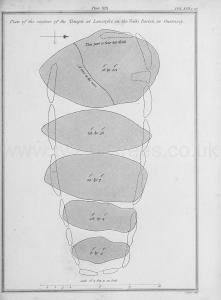
We have three more such temples in this island, but not so complete, nor so large, as the one I have just described.
One of these is situated near Paradis, at the Clos of the Vale, and is called "La Pierre du déhus [Map]." It stands on a rising ground, and slopes towards the east north east. The stones are of a grey granite. The supporting, or upright stones, are 2½ feet above the ground in the inside, and could not be more, as the bottom is rocky; they form a parallelogram in the inside of 12 feet broad. I send you two views of this temple, (Pl. XX.) and likewise a plan of the surface with the admeasurements, (Pl. XXI.)
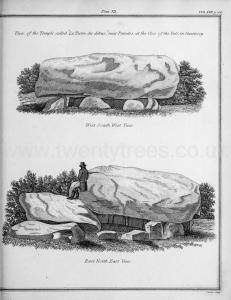
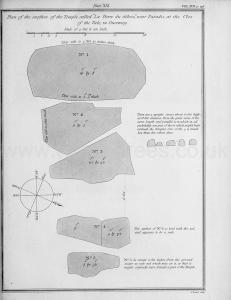
Another of these temples is seen at the Catioroc [Map], at St. Saviors, of which I have also the pleasure to send you two views, (PI. XXII. fig. 1, 2.)
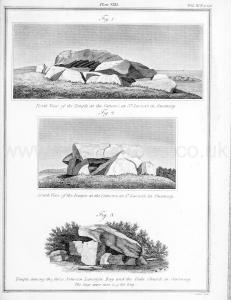
The third [La Mare es Mauves Burial [Map]] is situated between Lancresse Bay and the Valle Church, and is partly concealed by furze (PI. XXII. fig 3.).

Some years ago I discovered a very large Logan or rocking stone, on a rock at the opposite side of Lancresse Bay, which could easily be rocked by a child; but within these three years it has been entirely destroyed, and no vestige of it now remains. An ancient manuscript says that this island was originally inhabited by fishermen, who were Pagans, and used to place large stones one upon another near the sea shore, on which they performed their sacrifices. The stones of this kind which are now extant, are certainly all situated near the sea shore, and this circumstance so far corroborates the information given in the manuscript.
I have the honour to be,
Dear Sir,
Your obliged, and very humble servant,
JOSHUA GOSSELIN,